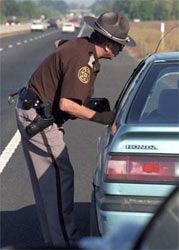 MPH Industries announces the release of its highly anticipated Ranger™ traffic radar unit. Ranger is the first traffic radar that can measure the distance of a vehicle in addition to its speed, functionally making it a cross between a traffic radar and a lidar (laser) unit. Ranger combines the ease of use and multi-target measurement capability of a traditional traffic radar with the positive target identification of a lidar.
MPH Industries announces the release of its highly anticipated Ranger™ traffic radar unit. Ranger is the first traffic radar that can measure the distance of a vehicle in addition to its speed, functionally making it a cross between a traffic radar and a lidar (laser) unit. Ranger combines the ease of use and multi-target measurement capability of a traditional traffic radar with the positive target identification of a lidar.
Ranger uses the traditional Doppler principle to determine speeds, so it takes advantage of all existing radar case law. However, its special microwave beam allows the operator to know the exact distance of each target it measures, allowing better target identification and tracking.
In addition, Ranger has a feature called SafetyZone™. When activated, SafetyZone continuously monitors the area behind the patrol vehicle, searching for drivers who fail to slow down in response to the vehicle’s emergency lights. When a dangerous vehicle is detected, Ranger activates a warning device outside of the patrol vehicle to warn the officer of the danger. The distance-measuring capability of Ranger is the key factor to minimizing false alarms, so that officers do not lose confidence in the alert.
Ranger is the first and only product on the market that will alert officers to the presence of dangerous vehicles when they are outside of their vehicle. Versions of the Ranger have also been introduced for DOT and other road worker applications which continuously operate in SafetyZone mode.
Kevin Willis, president of MPH, said of Ranger, “For more than a decade, distance-measuring has been recognized as being the next logical step for police radar. A number of companies have talked about ranging for years, but only MPH has made it viable and brought it to market. Our technology has been field-tested in our speed signs and trailers for over 3½ years, so we are confident that we have a reliable product to offer the market. Ranger will save lives and revolutionize speed enforcement.”
The primary benefits or Ranger’s technology are two-fold:
SafetyZone
When an officer makes a traffic stop, he can press a button to activate SafetyZone. Ranger then activates its rear antenna and alerts the officer to the presence of any vehicle traveling faster than a pre-determined speed, within a user-determined distance of the patrol vehicle.
This alert is broadcast to the officer using an external siren or light. SafetyZone can give the officer the opportunity to move to safety and avoid dangerous vehicles. SafetyZone can save lives.
Distance-measuring is crucial to making SafetyZone reliable. Traditional radars can only distinguish vehicles by speed or signal strength. Signal strength is a factor of both distance and the size of the vehicle, with larger vehicles giving a much larger signal strength. In order to alert the officer to small cars close to him, a traditional radar would also overreact by alerting him to large trucks that could be over ¾ mi. away.
Ranger’s distance information minimizes the number of false alarms of the system by filtering out the signals from large vehicles that are far from the patrol vehicle, and focusing on the speeders who are close to the patrol vehicle and are real threats to the officer’s safety.
MPH offers a number of external alert devices for the Ranger, but it can also use accessory equipment that is already present on the vehicle. In addition, Ranger can also warn the oncoming driver at the same time via a special light or message sign, giving them an additional incentive to slow down.
MPH is also producing an alert-only version of the Ranger, for use by any emergency services agency, road construction or maintenance agency, or tow operator. Ranger operates under Part 15 of the FCC rules, so there is no limitation on who can own or use the device.
Advanced Target Identification™
Recognizing which vehicle a radar is measuring is a major training point with traditional police radars. They tell the user the speed of the strongest and fastest vehicles, but they do not identify for the officer which specific vehicles are being measured.
That has been a key attraction of lidar (laser) equipment. The officer aims the laser at a specific vehicle, and that vehicle is the only one whose speed is displayed. However, lidars do have downsides: they are fatiguing to operate; they cannot work while the patrol vehicle is moving; and they can only measure one vehicle at a time.
In contrast, Ranger overcomes all of the downsides of lidar equipment.
• It is not fatiguing to operates, since it requires no aiming and less operator interaction.
• Ranger reports accurate speed and distance information whether the patrol vehicle is moving or stationary.
• The radar measures all of the vehicles that are in the radar beam, and continuously reports the speed and distance of the strongest and fastest vehicle moving in the selected direction.
For additional information, including informational literature on Ranger, SafetyZone, or Advanced Target Identification, contact:
Contact your MPH representative.
Photo of the Ranger radar
Ranger, SafetyZone, and Advanced Target Identification are all trademarks of MPH Industries, Inc.












